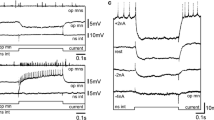Abstract
It was established during experiments on pedal ganglia generating locomotor rhythm isolated fromClione limacina, a pteropod mollusk, that this rhythm was irregular in 30% of preparations; i.e., the locomotor generator worked in bursts which alternated with periods of regular activity. Locomotor bursts were produced by excitation in command neurons located within the pedal ganglia. Single neurons were extracted from the ganglia in these preparations generating locomotor bursts by means of an intracellular microelectrode; their somata were then placed in their original sites amongst the ganglia cells. A total of 35 neurons were isolated showing changed activity during bursts. Nine of these cells renewed their erratic activity (linked to locomotor bursts) following reinsertion into the ganglion. Neurons which had initially shown an excitatory pattern during bursts continued to be excited; the same was true for inhibitory types. These observations indicate that the command neurons governing generator operation can act on target cells when morphological contact with them has been suppressed.
Similar content being viewed by others
Literature cited
Yu. I. Arshavskii, I. N. Beloozerova, G. N. Orlovskii, et al., "The activity of pteropod mollusk pedal ganglia neurons during generation of locomotor rhythm," Neirofiziologiya,16, No. 2, 269–271 (1984).
Yu. I. Arshavskii, I. N. Beloozerova, G. N. Orlovskii, et al., "The activity of pteropod mollusk pedal ganglia interneurons during generation of locomotor rhythm," Neirofiziologiya,16, No. 2, 272–275 (1984).
Yu. I. Arshavskii, I. N. Beloozerova, G. N. Orlovskii, et al., "Pteropod mollusk pedal ganglia governing the operation of the locomotor generator," Neirofiziologiya,16, No. 4, 543–546 (1984).
Yu. I. Arshavskii, G. N. Orlovskii, G. A. Pavlova, and Yu. V. Panchin, "Generation of locomotor rhythm by the pedal ganglia," Neirofiziologiya,14, No. 1, 102–104 (1984).
I. M. Gel'fand, V. S. Gurfinkel', M. L. Tsetlin, and M. L. Shik, "Aspects of research into motion," in: Structural and Functional Organizational Models of Some Biological Systems [in Russian], Nauka, Moscow (1966), pp. 264–276.
I. M. Gel'fand and M. L. Tsetlin, "Mathematical modeling of central nervous system mechanisms," ibid, in: pp. 9–26.
T. L. D'yakonova, "Two types of neurons differing in their plastic properties: a study of ionic mechanisms," Zh. Vyssh. Nerv. Deyat.,16, No. 3, 552–560 (1985).
N. M. Litvinova and G. N. Orlovskii, "Feeding and food behavior in the pteropod molluskClione limacine," Biol. MIOP. Otd. Biologii,90, No. 4, 73–77 (1985).
D. A. Sakharov, "Autonomy in the pedal ganglia of the pteropod (Clione limacina," Nauch. Dokl. Vyssh. Shkoly, Ser. Biol. Nauk, 3, No. 1, 60–62 (1980).
D. A. Sakharov, "Organization of heterogeneous neuronal systems," in: Proceedings of the 14th Congress of the I. P. Pavlov All-Union Physiological Society, Nauka, Leningrad,1, 175–177 (1983).
Yu. I. Arshavsky, I. N. Beloozerova, G. N. Orlovsky, et al., "Control of locomotion in the marine molluskClione limacina. 1. Efferent activity during actual and fictitious swimming," Exp. Brain Res.,58, No. 2, 255–262 (1985).
Yu. I. Arshavsky, I. N. Beloozerova, G. N. Orlovsky, et al., "Control of locomotion in the marine molluskClione limacina. 2. Rhythmic neurons of pedal ganglia," Exp. Brain Res.,58, No. 2, 263–272 (1985).
J. L. C. Cobb, "The neurobiology of the ectoneural/hyponeural synaptic connection in an echinoderm," Biol. Bull.,168, No. 3, 432–446 (1985).
R. K. Dismukes, "New concepts of molecular communication among neurons," Behav. Brain Sci.,2, No. 3, 409–448.
G. A. Horridge, "The organization of the primitive central nervous system as suggested by examples of inhibition and the structure of neuropile," in: Nervous Inhibition (E. Flcey, ed.), Pergamon Press, Oxford (1961), pp. 395–409.
L. L. Iversen, "Amino acids and peptides: fast and slow chemical signals in the nervous system," Proc. R. Soc. London, Ser. B,221, No. 1224, 245–260 (1984).
L. Y. Jan and Y. N. Jan, "Peptidergic transmission in sympathetic ganglia of the frog," J. Physiol.,327, 218–246 (1982).
E. Mayeri, P. Brownell, W. D. Branton, and S. B. Simon, "Multiple, prolonged actions of neuroendocrine bag cells of neurons ofAplysia," J. Neurophysiol.,42, No. 4, 1165–1184 (1979).
S. Sombati and G. Hoyle, "Generation of specific behaviors in a locust by local release into the neuropile of the natural neuromodulator octopamine," J. Neurobiol.,15, No. 6, 481–506 (1984).
Additional information
Institute for Research into Information Transmission, Academy of Sciences of the USSR, Moscow; M. V. Lomonosov State University. Moscow. Translated from Neirofiziologiya, Vol. 18, No. 6, pp. 756–763, November–December, 1986.
Rights and permissions
About this article
Cite this article
Arshavskii, Y.I., Gel'fand, I.M., Delyagina, T.G. et al. Influence of the pteropod mollusk pedal ganglia locomoter system on anatomically isolated neurons. Neurophysiology 18, 528–533 (1986). https://doi.org/10.1007/BF01057792
Received:
Issue Date:
DOI: https://doi.org/10.1007/BF01057792




